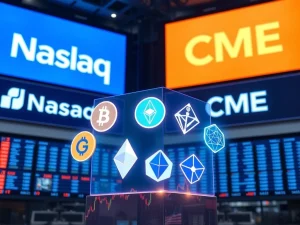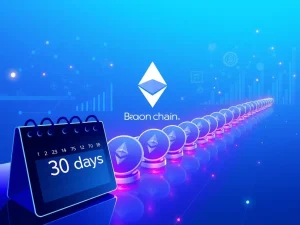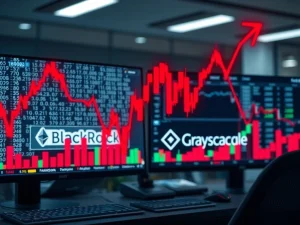Ethereum Price: Explosive Bull Flag Targets $4K Breakout as Institutional Demand Surges

Are you ready for the next big move in crypto? All eyes are on Ethereum as its technical charts flash strong bullish signals, mirroring patterns that have historically led to significant price surges. With a potential $4,000 target in sight and a noticeable rise in institutional demand, the stage seems set for Ethereum’s next major rally. Let’s dive into the latest Ethereum news and what it means for its future.
Ethereum Price: Unpacking the Bullish Signals
The current Ethereum price action is drawing considerable attention from analysts and investors alike. A key technical formation, the ‘right-angled descending broadening wedge’ on Ethereum’s weekly chart, suggests explosive price movements are on the horizon. This pattern, historically linked to significant breakouts, indicates Ethereum is poised for upward momentum. According to prominent analyst Titan of Crypto, short-term targets could reach $4,100, with a longer-term goal of $6,700 if Ethereum decisively breaks above the wedge’s upper boundary.
- Historical Performance: Ethereum has outperformed Bitcoin for two consecutive quarters in 2025, a trend not seen since 2021. Analyst Merlijn The Trader notes that similar periods historically preceded a fivefold return for Ethereum by year-end.
- Key Indicator Reclamation: The reclamation of the 50-week moving average is a strong bullish signal, indicating a shift towards a more positive market regime.
- On-Chain Activity: Current on-chain data shows a surge in large transactions, with Ali Martinez reporting $18 billion in whale activity. This suggests strategic positioning by large investors, signaling a bullish shift.
Why Institutional Demand is Fueling ETH’s Ascent
The surge in institutional demand for Ethereum is a critical factor driving its current bullish outlook. Large-scale investors, often referred to as ‘whales,’ are accumulating ETH, evidenced by the significant transaction volumes. This type of activity typically precedes major price movements, as institutions deploy capital with a long-term strategic intent.
The parallels to Bitcoin’s explosive 2020 bull market are striking. That rally, which saw Bitcoin surge from under $10,000 to nearly $60,000, was largely fueled by increasing institutional adoption and favorable macroeconomic conditions. Ethereum’s current trajectory appears to mirror this narrative, with similar catalysts emerging, including:
- Increased Wall Street involvement.
- A broader ‘risk-on’ sentiment across global financial markets.
- Comparisons by NasdaqBTC CEO to Bitcoin’s pre-2020 consolidation phase, highlighting growing institutional interest in Ethereum.
Such developments could significantly accelerate Ethereum’s adoption, making it more accessible to a wider range of investors and further solidifying its position in mainstream finance.
Is a $4K ETH Breakout Imminent?
The question on many investors’ minds is whether an ETH breakout to the $4,000 mark is truly imminent. Several converging factors suggest this target is increasingly plausible. The formation of a ‘bull flag’ pattern on Ethereum’s chart, a continuation formation often followed by sharp price increases, strongly supports this projection.
Optimism around upcoming Ethereum ETF approvals is also contributing to the positive sentiment. The potential for a spot Ethereum ETF, similar to the recently approved Bitcoin ETFs, could unlock significant new capital inflows from traditional finance. Furthermore, Elliott Wave theory strengthens the bullish case, with some experts identifying Ethereum in the third impulsive wave of a larger bullish cycle—historically the strongest phase of a trend. These projections even extend to a potential $9,000 level based on longer-term Elliott Wave analysis.
The Power of the Bull Flag Pattern
Understanding the bull flag pattern is crucial for grasping Ethereum’s current technical strength. A bull flag is a continuation chart pattern that occurs when a sharp price increase (the flagpole) is followed by a consolidation period, where the price drifts lower or sideways within a channel (the flag). This consolidation typically occurs on decreasing volume, indicating that selling pressure is waning. A breakout above the flag’s upper boundary signals a resumption of the prior uptrend, often with a target equal to the height of the flagpole.
On Ethereum’s chart, this pattern reinforces market psychology and grows investor confidence. Each touch of support or resistance within the pattern helps to solidify its validity, making the potential for a significant upward move more likely. This pattern, combined with the other bullish indicators, creates a compelling technical case for Ethereum.
What the Latest Ethereum News Means for Investors
The confluence of strong technical patterns, favorable macroeconomic conditions, and surging institutional activity paints a promising picture for Ethereum. The latest Ethereum news indicates a robust foundation for a sustained rally, unlike previous cycles. On-chain metrics show reduced selling pressure and increased network activity, signaling a healthier market.
Despite the overwhelming bullish signals, challenges remain. Short-term resistance zones and potential volatility could test the current upward momentum. A critical $3,800 support level has been forming, and a breach below this threshold could invalidate the immediate bullish setup. Investors are advised to monitor these key levels closely.
In conclusion, Ethereum appears to be on the cusp of a significant price breakout, driven by a powerful combination of technical indicators and burgeoning institutional interest. While market dynamics always carry risk, the current environment suggests a strong potential for Ethereum to challenge and potentially surpass its all-time highs. Stay informed, stay vigilant, and prepare for what could be an exciting period for the second-largest cryptocurrency.
Frequently Asked Questions (FAQs)
Q1: What is a ‘bull flag’ pattern and why is it important for Ethereum?
A bull flag is a bullish continuation pattern on a price chart. It forms after a strong upward price move (the flagpole), followed by a brief consolidation period (the flag) where the price moves sideways or slightly downwards. It’s important for Ethereum because it often signals that the prior upward trend is likely to resume, potentially leading to significant price increases once the price breaks out of the flag formation.
Q2: How does institutional demand impact Ethereum’s price?
Institutional demand significantly impacts Ethereum’s price by bringing large amounts of capital into the market. When major financial institutions and large investors (whales) buy ETH, it increases buying pressure, reduces available supply, and signals confidence in the asset, which can drive the price up. This influx of professional capital adds stability and legitimacy to the market.
Q3: What are the key price targets for Ethereum if it breaks out?
Analysts are projecting several key price targets for Ethereum. Short-term targets based on the ‘right-angled descending broadening wedge’ and bull flag pattern include $4,000 and $4,100. Longer-term targets, especially if the broader bullish cycle continues as per Elliott Wave theory, could potentially reach $6,700 and even $9,000.
Q4: What challenges could prevent Ethereum from reaching its $4K target?
While the outlook is bullish, potential challenges include short-term resistance zones and market volatility. A critical support level around $3,800 needs to hold; a sustained breach below it could invalidate the immediate bullish setup. Broader market downturns or unexpected regulatory news could also impact its trajectory.
Q5: How does Ethereum’s current performance compare to Bitcoin’s 2020 bull run?
Ethereum’s current trajectory shows striking parallels to Bitcoin’s 2020 bull run. Both periods are characterized by increasing institutional adoption, favorable macroeconomic tailwinds, and significant technical breakout patterns. Ethereum outperforming Bitcoin for two consecutive quarters further strengthens this comparison, suggesting it might be on the cusp of a similar explosive growth phase.










